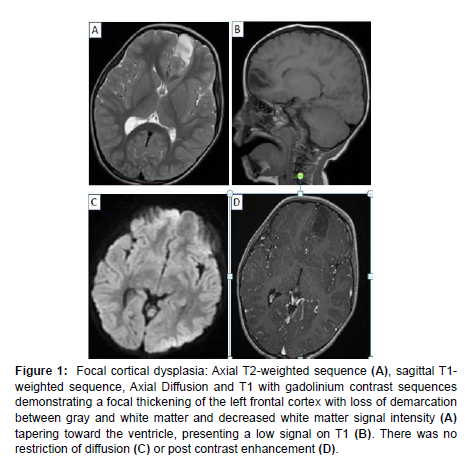Focal Cortical Dysplasia in a 10 years Old Boy with Refractory Epilepsy
Received: 05-Sep-2022 / Manuscript No. roa-22- roa-22-74434 / Editor assigned: 07-Sep-2022 / PreQC No. roa-22-74434 (PQ) / Reviewed: 21-Sep-2022 / QC No. roa-22- roa-22-74434 / Revised: 23-Sep-2022 / Manuscript No. roa-22-74434 (R) / Published Date: 30-Sep-2022
Image Article
FCD is the most commonly resected epileptogenic lesion in children and the third most common epileptogenic lesion in adults. They are described as inborn (developmental) malformed cerebral cortical regions that cover a wide range of histopathological abnormalities [1].
According to the ILAE’s three-tiered light-microscopical classification, FCD type I is a malformation with aberrant cortical layering while FCD type II is a congenital disorder characterized by impaired cortical lamination and particular cytological abnormalities [1].
Focal cortical dysplasias are among the most common causes of refractory epilepsy and have been linked to hippocampal sclerosis and cortical glioneuronal neoplasms [2].
MRI is the preferred modality for evaluating patients who may have focal cortical dysplasias [2].
MRI protocols for patients with drug-resistant focal epilepsies are mostly standardized [1].
The imaging characteristics of the various kinds of FCD are highly overlapping, and many times there is no obvious MRI abnormality [2] (Figure 1).
Figure 1: Focal cortical dysplasia: Axial T2-weighted sequence (A), sagittal T1- weighted sequence, Axial Diffusion and T1 with gadolinium contrast sequences demonstrating a focal thickening of the left frontal cortex with loss of demarcation between gray and white matter and decreased white matter signal intensity (A) tapering toward the ventricle, presenting a low signal on T1 (B). There was no restriction of diffusion (C) or post contrast enhancement (D).
These are some common radiological features of localized cortical dysplasia:
• Increased cortical thickness with white matter-grey matter junction blurring
• Aberrant subcortical layer architecture.
• White matter T2/FLAIR signal hyper intensity with or without Transmantle sign.
• Hyper intensity of the T2/FLAIR signal in the grey matter
• Aberrant segmental and/or lobar hypoplasia/atrophy with a sulcal or gyral pattern.
References
- Urbach H, Kellner, E., Kremers, N, Blümcke I, Demerath T (2022) MRI of focal cortical dysplasia. Neuroradiology 64: 443-452.
- Gaillard F, Dufresne D (2022) Focal cortical dysplasia.
Indexed at, Google Scholar, Crossref
Citation: Jihad B, Hind S, Khadija L, Haddad S, Allali N, et al. (2022) Focal Cortical Dysplasia in a 10 years Old Boy with Refractory Epilepsy. OMICS J Radiol 11: 402.
Copyright: © 2022 Jihad B, et al. This is an open-access article distributed under the terms of the Creative Commons Attribution License, which permits unrestricted use, distribution, and reproduction in any medium, provided the original author and source are credited.
Share This Article
Open Access Journals
Article Usage
- Total views: 1071
- [From(publication date): 0-2022 - Mar 29, 2025]
- Breakdown by view type
- HTML page views: 750
- PDF downloads: 321

